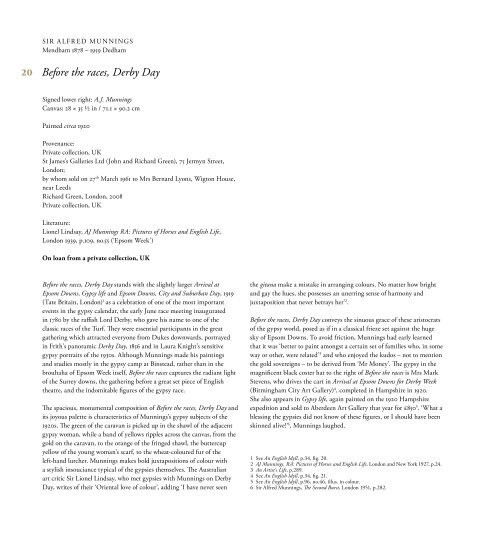An Artist’s Life
Munnings - Richard Green
Munnings - Richard Green
You also want an ePaper? Increase the reach of your titles
YUMPU automatically turns print PDFs into web optimized ePapers that Google loves.
20<br />
SIR ALFRED MUNNINGS<br />
Mendham 1878 – 1959 Dedham<br />
Before the races, Derby Day<br />
Signed lower right: A.J. Munnings<br />
Canvas: 28 × 35 ½ in / 71.1 × 90.2 cm<br />
Painted circa 1920<br />
Provenance:<br />
Private collection, UK<br />
St James’s Galleries Ltd (John and Richard Green), 75 Jermyn Street,<br />
London;<br />
by whom sold on 27 th March 1961 to Mrs Bernard Lyons, Wigton House,<br />
near Leeds<br />
Richard Green, London, 2008<br />
Private collection, UK<br />
Literature:<br />
Lionel Lindsay, AJ Munnings RA: Pictures of Horses and English <strong>Life</strong>,<br />
London 1939, p.109, no.55 (‘Epsom Week’)<br />
On loan from a private collection, UK<br />
Before the races, Derby Day stands with the slightly larger Arrival at<br />
Epsom Downs, Gypsy life and Epsom Downs, City and Suburban Day, 1919<br />
(Tate Britain, London) 1 as a celebration of one of the most important<br />
events in the gypsy calendar, the early June race meeting inaugurated<br />
in 1780 by the raffish Lord Derby, who gave his name to one of the<br />
classic races of the Turf. They were essential participants in the great<br />
gathering which attracted everyone from Dukes downwards, portrayed<br />
in Frith’s panoramic Derby Day, 1856 and in Laura Knight’s sensitive<br />
gypsy portraits of the 1930s. Although Munnings made his paintings<br />
and studies mostly in the gypsy camp at Binstead, rather than in the<br />
brouhaha of Epsom Week itself, Before the races captures the radiant light<br />
of the Surrey downs, the gathering before a great set piece of English<br />
theatre, and the indomitable figures of the gypsy race.<br />
The spacious, monumental composition of Before the races, Derby Day and<br />
its joyous palette is characteristics of Munnings’s gypsy subjects of the<br />
1920s. The green of the caravan is picked up in the shawl of the adjacent<br />
gypsy woman, while a band of yellows ripples across the canvas, from the<br />
gold on the caravan, to the orange of the fringed shawl, the buttercup<br />
yellow of the young woman’s scarf, to the wheat-coloured fur of the<br />
left-hand lurcher. Munnings makes bold juxtapositions of colour with<br />
a stylish insouciance typical of the gypsies themselves. The Australian<br />
art critic Sir Lionel Lindsay, who met gypsies with Munnings on Derby<br />
Day, writes of their ‘Oriental love of colour’, adding ‘I have never seen<br />
the gitana make a mistake in arranging colours. No matter how bright<br />
and gay the hues, she possesses an unerring sense of harmony and<br />
juxtaposition that never betrays her’ 2 .<br />
Before the races, Derby Day conveys the sinuous grace of these aristocrats<br />
of the gypsy world, posed as if in a classical frieze set against the huge<br />
sky of Epsom Downs. To avoid friction, Munnings had early learned<br />
that it was ‘better to paint amongst a certain set of families who, in some<br />
way or other, were related’ 3 and who enjoyed the kudos – not to mention<br />
the gold sovereigns – to be derived from ‘Mr Money’. The gypsy in the<br />
magnificent black coster hat to the right of Before the races is Mrs Mark<br />
Stevens, who drives the cart in Arrival at Epsom Downs for Derby Week<br />
(Birmingham City Art Gallery) 4 , completed in Hampshire in 1920.<br />
She also appears in Gypsy life, again painted on the 1920 Hampshire<br />
expedition and sold to Aberdeen Art Gallery that year for £850 5 . ‘What a<br />
blessing the gypsies did not know of these figures, or I should have been<br />
skinned alive!’ 6 , Munnings laughed.<br />
1 See <strong>An</strong> English Idyll, p.34, fig. 20.<br />
2 AJ Munnings, RA: Pictures of Horses and English <strong>Life</strong>, London and New York 1927, p.24.<br />
3 <strong>An</strong> Artist's <strong>Life</strong>, p.289.<br />
4 See <strong>An</strong> English Idyll, p.34, fig. 21.<br />
5 See <strong>An</strong> English Idyll, p.96, no.46, illus. in colour.<br />
6 Sir Alfred Munnings, The Second Burst, London 1951, p.282.


